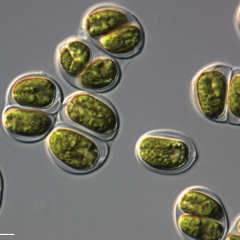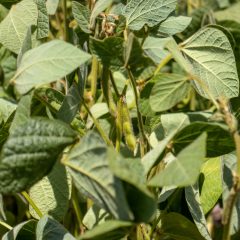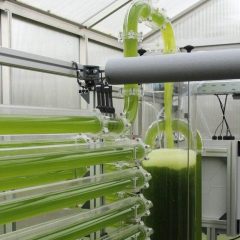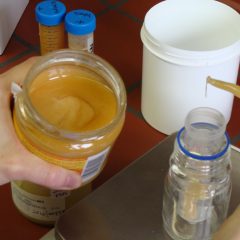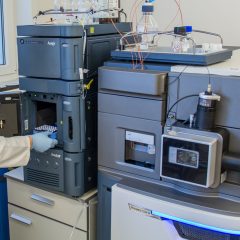Dossier Protein diversification in food and nutrition
Our society is changing, and so are our eating habits. The group of people seeking vegetarian and vegan foods is growing more and more. But which food sources can provide us with proteins? What amino acids do these new proteins contain? What alternative proteins are out there?

What does ILVO do?
-
 In the Food Pilot, ILVO has a complete protein research line for research from primary product to final product
In the Food Pilot, ILVO has a complete protein research line for research from primary product to final product -
 Research on different protein sources such as legumes, macro- and microalgae, microbial proteins, seeds, ... and their properties
Research on different protein sources such as legumes, macro- and microalgae, microbial proteins, seeds, ... and their properties -
Valorization of certain by-products of food processing that are rich in protein
-
 Study of the feasibility of growing and breeding protein crops such as soy, quinoa, lupin, peas, beans and lentils in Flanders
Study of the feasibility of growing and breeding protein crops such as soy, quinoa, lupin, peas, beans and lentils in Flanders
Rising demand for alternative proteins in Flanders
The demand for alternative proteins is growing rapidly, both among consumers and producers. Eating alternative proteins can be done because of a particular dietary pattern such as vegan, vegetarian or flexitarian, for animal welfare, sustainability or health reasons or simply because it tastes good.
For conventional animal protein sources such as dairy, meat, fish or eggs, we rely on age-old nutritional wisdom and many decades of study. Alternative protein sources are less obvious. There is a lack of knowledge about plant proteins, microbial proteins or protein from (micro)algae or insects. Through research with various partners, ILVO is trying to fill these knowledge gaps.ILVO is committed to research on protein diversification. The gradual diversification of proteins will eventually ensure increased availability and more knowledge about alternatives to animal proteins.
What challenges does protein diversification pose? What research still needs to be conducted?
Producers and processors looking to tap into those new (niche) markets need clear, scientifically verified, technical information. Some of the challenges under study are:
- How do alternative proteins respond to processing? That the protein from a chicken egg solidifies when cooked has long been known, but what do proteins from, say, soy, peas or lupin do?
- Which vegetable proteins react in a similar way to animal proteins, and which ones just don't?
- What does the protein from e.g. quinoa or beans taste like, and what is the mouthfeel [dossier voeding smaak etc]?
- What nutritional value do they have, and that both on a macro and micro level?
- What clever combinations of protein sources are there to include all the essential amino acids?
- Are the proteins easily digestible? And is there any risk of allergic reactions [dossier allergies] e.g. nuts and insects?
- How well does the consumer accept the new proteins?
- Can the proteins be easily processed, or are there any (microbiological or chemical) hazards involved?
- What is the total environmental impact of proteins, from cultivation to end product (life cycle analysis or LCA)?
Which plants (species) qualify as protein suppliers?
Useful proteins are found in many different plant species. The higher the proportion of protein, the more interesting. But not only the proportion of protein is important. The composition of a protein (the amino acids) is also important. There are 22 different amino acids, divided into essential and non-essential amino acids. The body can make non-essential amino acids itself, but for the essential amino acids we have to rely on our food. Proteins rich in essential amino acids are thus much more interesting in protein diversification.
Unlike meat and dairy, plant-based protein sources rarely have a complete amino acid profile, meaning that not all the essential amino acids are present. Because of the lower levels of certain amounts of essential amino acids, there is a need for clever combinations, such as the combination of rice (rich in methionine and cysteine, and low in lysine) and beans (low in methionine and cysteine, and high in lysine).
Protein-rich plants include legumes such as soy [dossier soy], edamame, chickpeas, lentils, peas, (field) beans and lupin. There are also certain (pseudo)cereals such as quinoa [dossier quinoa] with a high proportion of high-quality proteins rich in essential amino acids. But proteins can also be found in seeds, kernels and nuts such as sunflower seeds or walnuts.
Some of these crops have already found their way to Flemish fields, others are still in the research phase. For the cultivation of these plants we count on our farmers. To help them further with these new crops, ILVO not only conducts research into the processing and properties of the vegetable proteins, but also into the needs, requirements and breeding of the different types of plants. With the knowledge gathered during the research, the crops can be optimally cultivated in the field for maximum yield.
Other alternative protein sources
In addition to plant proteins, there are other alternative sources of protein. For example, certain insects such as grasshoppers, crickets and mealworms can be a rich source of protein, or (micro)algae. But microbial proteins or proteins derived from fermentation also belong to this list. Whereas with plant proteins the proportion and content of proteins depend on the plant species, microbial proteins can be biochemically controlled and made to fit optimally within a particular diet or for a particular processing afterwards.
Consumer acceptance
With proteins derived from plant sources, the transition for consumers is small and recognizable. This is different with proteins derived from insects or from fermentation. Here it is important that properties such as taste, color, odor and texture are included in the various studies. For example, vegetarian minced 'meat' from Quorn® (mycoproteins) is recognizable because it is similar to animal-based minced meat.
Sustainable proteins
The production of animal proteins has an impact on animal welfare, environment and climate which sometimes gives them a negative stigma. But alternative sources of proteins also have an impact, which is why it is also important to pay due attention to sustainability. How much energy do proteins coming from a fermentation tank require? What is the impact of certain crops on soil or environment? What fertilization do plants require? Are insects sufficient for some residual streams or do specific things need to be present that might completely undercut the potentially positive impact? Does alternative protein production also emit greenhouse gases? With protein diversification, the goal is to produce more and different proteins with less impact. If this cannot be done, then other alternatives or optimization of current production methods should be explored further.
Contact an expert

